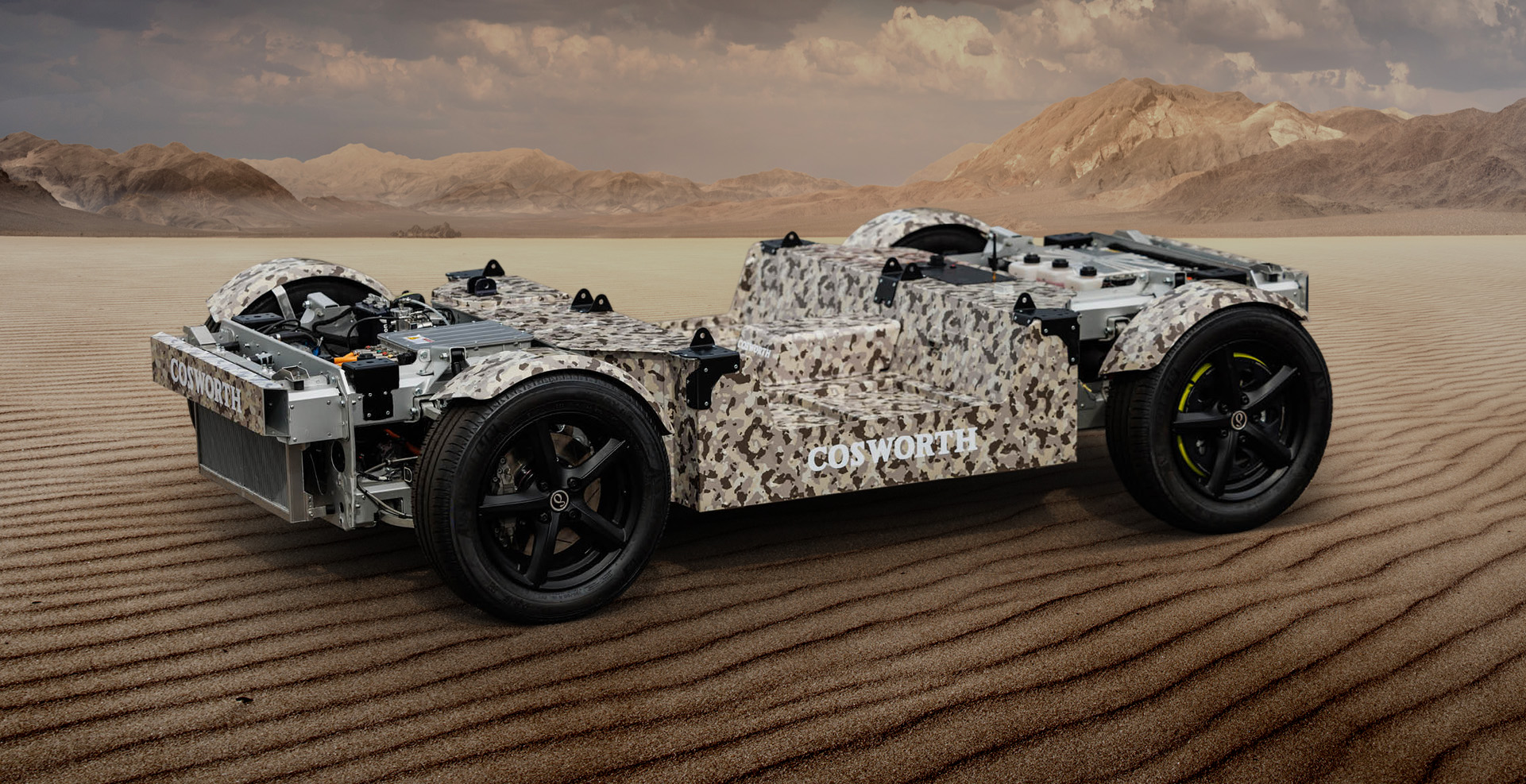The Cosworth S2 modular vehicle is a flexible vehicle development platform, aimed at giving manufactures a solid base chassis and control systems for electric vehicle development, offering them an easy to use, modular and scalable tool to address the challenges posed by autonomous driving research.

OVERVIEW
We began investigating a novel approach to vehicle design and control. We wanted to combine the distributed control strategies found in traditional vehicles, where separate electronic control hardware managed various functions such as ABS, steering, and engine control. Instead, we envisioned a centralised Platform Master Controller (PMC) capable of handling all aspects of the vehicle’s movement, including electric powertrain management.
The S2 is an adaptable, modular vehicle prototype. It uses a flat chassis with a body mounted on top. This approach aids the modularity of the vehicle, as common mounting points mean that a variety of bodies can be attached to the same chassis. The purpose of the S2 led to this style of design. There needed to be a diverse range of possible applications built into the vehicles architecture to cater for a wide variety of industries, from passenger cars and off-road vehicles to airport ground handling.
The S2 is primarily aimed towards companies wanting to evaluate autonomous driving requirements. By offering a standardised solution, the PMC within the S2 allows rapid integration of customer-specific software and hardware, accelerating the development process.
DEVELOPMENT
The S2 was designed and built with versatility in mind, with two motors at one end that offer significant power and a single motor coupled to a gearbox and differential at the other. This enables simultaneous development and evaluation of both single motor and dual motor configurations. This key feature of the S2 allows quick analysis of multiple drivetrain options. It showcases the platform’s flexibility as it has the ability to handle both powerful and cost-effective options.
Initially, we intended to have the same suspension system for both the front and rear ends of the vehicle. While we got close to achieving this goal, specific requirements related to the differing front and rear motor concepts forced us to compromise on completely identical setups; as a result, there are some subtle design variations.
The S2 features a double wishbone suspension system. Other configurations were considered, however, with our performance vehicle experience, a double wishbone system was chosen to provide high levels of chassis control in a variety of applications, including both on and off-road uses.
The near-identical suspension set up enables us to implement four-wheel steering, which is advantageous for autonomous driving systems. Tighter turning circles and driving in diagonal motion add a large degree of manoeuvrability over conventional steering systems.
We also recognised that handling is a redundant concept for autonomous vehicles, so our efforts were heavily focused on ride comfort. Many existing autonomous vehicles are developed using an existing road car, which already has ride and handling characteristics built in. As humans are not driving the vehicle, we instead evaluated different suspension options for optimal ride comfort while ensuring we didn’t compromise the platform’s performance adaptabilities.
The central section of the chassis is also flexible and modular. It has been designed to take varying arrangements of our Cylindrical Scalable Module (CSM) battery pack. The width is fixed but the battery compartment lengthens, extending the wheelbase to fit more modules, which translates to capacity and power scaling up with the payload of the vehicle.
The PMC was another important area for development. We wanted to allow customers to deploy and assess their own control strategies quickly and efficiently. The PMC aims to consolidate multiple controllers into one, simplifying data management and providing easy user interface development. Its versatility enables the PMC to cater to a diverse range of vehicle applications, from cars to marine vehicles, offering efficient power delivery control and supporting essential functionalities like steering and braking.
One significant challenge we faced during development was managing vast amounts of data while ensuring efficient processing through a single controller. To overcome this, we rationalised the data acquisition process by focusing on the critical information for control and filtering out non-essential data. This approach ensured high levels of performance while avoiding the need for an excessively complex and costly controller.
The open architecture of the PMC showcases its adaptability through multiple use cases. It was used in Gordon Murray Design’s autonomous urban pod. The system’s simplicity and adaptability also allowed it to be implemented in a high-performance electric vehicle that was used to compete for the Nürburgring’s electric lap record.
Another key strength of the PMC lies in its user-friendly interface. The simple and straightforward signal tracking mechanism allows for easy block tracing, simplifying the development process. This feature sets the system apart from other complex conventional control alternatives.
As the automotive industry continues to evolve towards autonomous EV vehicles, development platforms like our S2 with an integrated PMC have great potential for accommodating a wide range of needs and applications, demonstrating the possibilities and versatility of autonomous mobility.